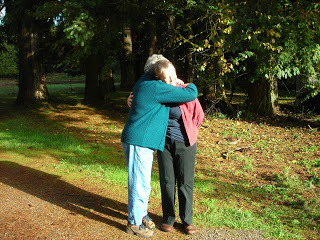Deborah J. Ross's Blog, page 138
October 18, 2013
GUEST BLOG: Janet Freeman on Gratitude and Stewardship
I was awed and inspired by how fully my friend lived the almost-five years between her diagnosis with Stage 4 ovarian cancer and her death last week. I am reminded that a terminal diagnosis does not mean we stop living -- it is an invitation to make every moment count, and thereby enrich not only the life of the patient but those around her. Here is author and lung cancer patient Janet Freeman-Daily on her own experience of hope, illness, and the zest of being alive.
I’m grateful to be here. Actually, I’m grateful to be anywhere. I’m grateful to be alive. The fact that I’m alive is a modern-day medical miracle.
In May of 2011, after a few months of a persistent cough, I was
diagnosed with pneumonia caused by advanced lung cancer. No, I never
smoked anything except a salmon. Five months after diagnosis, despite
chemo and radiation, the cancer spread outside my chest and I was given
at most two years to live. A year later, after more treatment and
another recurrence, I learned my cancer had a rare mutation. Last
October, I found a clinical trial that could treat that mutation with an
experimental pill, and I flew to Denver to get it. In January, I
achieved the dream of all metastatic cancer patients: No Evidence of
Disease. My cancer is no longer detectable.
I am overwhelmingly grateful for everything and everyone that has
brought me to this state of grace: medical science that discovered new
ways to treat my condition, insurance that paid for most of my care,
family and friends who supported me, a knowledgeable online lung cancer
community, and all the prayers and good wishes lifting me up throughout
my cancer journey. Thank you. I am truly blessed.
I am not cured. The tri
al drug only suppresses my cancer, and I
have some permanent side effects. I’ll be in treatment for the rest of
my days. Clinical trials will hopefully keep me feeling comfortable
and capable for many months – even years. I am satisfied with living
however long I might have.
Being given a second chance at life tends to give one a different
perspective. Colors are brighter. A warm breeze rustling the trees
makes the whole day worthwhile. Time spent with family and friends
becomes precious.
A second chance at life also makes one introspective. Why was I
spared when others died? Why does my mutation have an effective
treatment when others don’t? Why am I able to see one of the best lung
cancer doctors in the world when many patients can’t afford proper
treatment?
Why am I still here? What purpose does the universe have for me?
Part of the answer to why I’m still here is, I am blessed with gifts
that help me survive my cancer journey. I’m able to understand the
medical science and my treatment. I’m able to explain what I’ve
learned. And I’m able to advocate for myself with healthcare providers.
Yet I am just a steward of these gifts that were bestowed on me.
Understanding my gifts has led me to a new purpose: I am here to help
other lung cancer patients. I strongly feel this is my calling in the
time I have left.
Lung cancer has a stigma attached to it. Few people know that 80% of
those newly diagnosed with lung cancer are nonsmokers or never
smokers. There is more to lung cancer than just smoking. Yet we are
the lepers of the cancer community.
For this reason, some are ashamed to admit they have lung cancer.
Most don’t know about the new treatments like the one I’m taking–even
some doctors don’t know. Patients don’t know where to turn for answers.
Lung cancer patients need more than compassion. They need information. They need HOPE.
After considerable thought, I decided the best way to use my gifts
was to go public about my lung cancer. At first, I only shared my story
online with friends and lung cancer communities. Eventually I started
blogging (which is essentially a journal open to the world on the
Internet) and began speaking publicly about my cancer.
Going public with my lung cancer experience has already had an
impact. As I’d hoped, it shows patients that people can live with
metastatic lung cancer, and encourages them to ask questions about their
treatment.
But going public has also brought completely unexpected benefits. It
helps families understand what their loved ones who have lung cancer are
experiencing. It gives hospital chaplains insight into their patients’
needs and feelings. It demonstrates to doctors that patients can be
partners in their own care. It reveals to researchers how their work
makes a difference in the lives of real patients.
In addition, I’ve realized a personal health benefit in sharing the
gifts I was given to steward. Having a purpose gets me through the
tougher parts of cancer treatment. It won’t heal my cancer, but it does
help me live a healthier, happier life.
And it all started with being grateful that I’m alive.
~o0o~
About herself, Janet says: "I’ve made a career as a “technical translator” of

sorts: I research a
scientific or engineering subject, describe it to others in less
technical terms, and help them understand how this new gizmo could
benefit them. I applied my engineering degrees (MIT SBME 1978, Caltech
Aeronautics MS 1984 and Engineer 1986) to a career in aerospace systems
engineering for two decades, interacting with customers, developing new
products and writing proposals. I spent over 12 years caring for
elderly family members who had dementia. My adult son, who I adopted
when he was three, is on the autism spectrum. I now write science
articles and science fiction, sometimes under the pen name “Janet
Freeman,” and speak on science panels at science fiction conventions,
where I’m told I “give good science.”
Her blog is here.http://grayconnections.wordpress.com/

I’m grateful to be here. Actually, I’m grateful to be anywhere. I’m grateful to be alive. The fact that I’m alive is a modern-day medical miracle.
In May of 2011, after a few months of a persistent cough, I was
diagnosed with pneumonia caused by advanced lung cancer. No, I never
smoked anything except a salmon. Five months after diagnosis, despite
chemo and radiation, the cancer spread outside my chest and I was given
at most two years to live. A year later, after more treatment and
another recurrence, I learned my cancer had a rare mutation. Last
October, I found a clinical trial that could treat that mutation with an
experimental pill, and I flew to Denver to get it. In January, I
achieved the dream of all metastatic cancer patients: No Evidence of
Disease. My cancer is no longer detectable.
I am overwhelmingly grateful for everything and everyone that has
brought me to this state of grace: medical science that discovered new
ways to treat my condition, insurance that paid for most of my care,
family and friends who supported me, a knowledgeable online lung cancer
community, and all the prayers and good wishes lifting me up throughout
my cancer journey. Thank you. I am truly blessed.
I am not cured. The tri
al drug only suppresses my cancer, and I
have some permanent side effects. I’ll be in treatment for the rest of
my days. Clinical trials will hopefully keep me feeling comfortable
and capable for many months – even years. I am satisfied with living
however long I might have.
Being given a second chance at life tends to give one a different
perspective. Colors are brighter. A warm breeze rustling the trees
makes the whole day worthwhile. Time spent with family and friends
becomes precious.
A second chance at life also makes one introspective. Why was I
spared when others died? Why does my mutation have an effective
treatment when others don’t? Why am I able to see one of the best lung
cancer doctors in the world when many patients can’t afford proper
treatment?
Why am I still here? What purpose does the universe have for me?
Part of the answer to why I’m still here is, I am blessed with gifts
that help me survive my cancer journey. I’m able to understand the
medical science and my treatment. I’m able to explain what I’ve
learned. And I’m able to advocate for myself with healthcare providers.
Yet I am just a steward of these gifts that were bestowed on me.
Understanding my gifts has led me to a new purpose: I am here to help
other lung cancer patients. I strongly feel this is my calling in the
time I have left.
Lung cancer has a stigma attached to it. Few people know that 80% of
those newly diagnosed with lung cancer are nonsmokers or never
smokers. There is more to lung cancer than just smoking. Yet we are
the lepers of the cancer community.
For this reason, some are ashamed to admit they have lung cancer.
Most don’t know about the new treatments like the one I’m taking–even
some doctors don’t know. Patients don’t know where to turn for answers.
Lung cancer patients need more than compassion. They need information. They need HOPE.
After considerable thought, I decided the best way to use my gifts
was to go public about my lung cancer. At first, I only shared my story
online with friends and lung cancer communities. Eventually I started
blogging (which is essentially a journal open to the world on the
Internet) and began speaking publicly about my cancer.
Going public with my lung cancer experience has already had an
impact. As I’d hoped, it shows patients that people can live with
metastatic lung cancer, and encourages them to ask questions about their
treatment.
But going public has also brought completely unexpected benefits. It
helps families understand what their loved ones who have lung cancer are
experiencing. It gives hospital chaplains insight into their patients’
needs and feelings. It demonstrates to doctors that patients can be
partners in their own care. It reveals to researchers how their work
makes a difference in the lives of real patients.
In addition, I’ve realized a personal health benefit in sharing the
gifts I was given to steward. Having a purpose gets me through the
tougher parts of cancer treatment. It won’t heal my cancer, but it does
help me live a healthier, happier life.
And it all started with being grateful that I’m alive.
~o0o~
About herself, Janet says: "I’ve made a career as a “technical translator” of

sorts: I research a
scientific or engineering subject, describe it to others in less
technical terms, and help them understand how this new gizmo could
benefit them. I applied my engineering degrees (MIT SBME 1978, Caltech
Aeronautics MS 1984 and Engineer 1986) to a career in aerospace systems
engineering for two decades, interacting with customers, developing new
products and writing proposals. I spent over 12 years caring for
elderly family members who had dementia. My adult son, who I adopted
when he was three, is on the autism spectrum. I now write science
articles and science fiction, sometimes under the pen name “Janet
Freeman,” and speak on science panels at science fiction conventions,
where I’m told I “give good science.”
Her blog is here.http://grayconnections.wordpress.com/

Published on October 18, 2013 01:00
October 15, 2013
BOOK RELEASE! Mad Science Cafe (anthology)
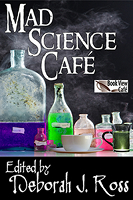
My latest anthology, from Book View Cafe!
From the age of steam and the heirs of Dr. Frankenstein to the asteroid
belt to the halls of Miskatonic University, the writers at Book View
Café have concocted a beakerful of quaint, dangerous, sexy, clueless,
genius, insane scientists, their assistants (sometimes equally if not
even more deranged, not to mention bizarre), friends, test subjects, and
adversaries.
Table of Contents:
The Jacobean Time Machine, by Chris Dolley
Comparison of Efficacy Rates, by Marie Brennan
A Princess of Wittgenstein, by Jennifer Stevenson
Mandelbrot Moldrot, by Lois Gresh
Dog Star, by Jeffrey A. Carver
Secundus, by Brenda W. Clough
Willie, by Madeleine E. Robins
One Night in O’Shaughnessy’s Bar, by David D. Levine
Revision, by Nancy Jane Moore
Night Without Darkness, by Shannon Page & Mark J. Ferrari
The Stink of Reality, by Irene Radford
“Value For O,” by Jennifer Stevenson
The Peculiar Case of Sir Willoughby Smythe, by Judith Tarr
The Gods That Men Don’t See, by Amy Sterling Casil
You can download a sample from the BVC bookstore, too. This anthology includes both original and reprint stories and is available as mobi and epub formats, so you can download the version that's right for your ereader. Best of all, because BVC is an author's publishing cooperative, 95% of the price goes to the authors themselves.

Published on October 15, 2013 01:00
October 14, 2013
Book View Cafe Editor Interview

Over at Book View Cafe blog, Katharine Eliska Kimbriel interview me "with my editor hat on."
When did you become interested in editing other writers’ work as opposed to concentrating on writing?
I first started thinking about editing during the years when I’d
visit Marion Zimmer Bradley on a regular basis. I helped read slush for
her magazine (MZB’s Fantasy Magazine) and
we’d talk. I got a “behind the scenes” look at what she looked for and
why, and how she handled rejection letters. She taught me that the work
of an editor isn’t mysterious, in part because her own tastes were so
definite. A story could be perfectly good but not suit the anthology or
magazine she was reading for, or might do both but not “catch fire” for
her. I learned about “no fault” rejections (and I’ve received them
myself, for example if the editor had just bought a story on the same
theme by a Big Name Author) and that sometimes if an editor thought the
story had merit but didn’t fulfill its promise, she could comment on its
shortcomings or issue an invitation to re-submit after revision. I
thought, “I can do this!” I’d had so many experiences from the Author
side of the desk, I approached editing with a set of wild hopes and
convictions.
What are the special challenges of editing in a shared world as opposed to a theme anthology?
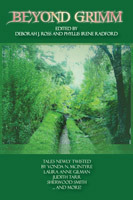
I think the crucial thing is a solid idea about how rigid (or
conversely how flexible) the structure is. The more rigid, the deeper
into the slush pile you’re going to have to dig (assuming it’s open
submission) or the more you’re going to risk throttling the creative
vision of your writers. So you need to be clear about what’s essential.
For example, if I were editing a Star Wars anthology and a writer
submitted a story that was essentially a bodice-ripper, no matter how
excellently done, I’d have to turn it down. That’s too great a violation
of the parameters. Just as with an individually-authored work, you’re
making a contract with your reader. Put your imagination in my/our hands
and this is the kind of experience you’ll have. (Not that there
won’t be surprises; good writing abounds in unexpected twists and
conventions-turned-upside-down.)
On the other hand, many shared worlds
offer latitude for “alternate versions,” especially when told from the
point of view of a not-entirely-reliable narrator. For myself, I would
rather see a story that bends the rules a little but does so in the
service of the clarity and passion of the author’s vision, than a
lifeless one that conforms strictly, one that follows the letter but not
the spirit of the guidelines. I suspect Marion influenced me in this
because she herself never let previously-established details get in the
way of a really good story.
Read more here.

Published on October 14, 2013 12:53
October 11, 2013
ARCHVES: Murder, the Death Penalty, and Cancer
Because I'll be busy helping with my friend's memorial and other family issues, I'm reposting something from a couple of years ago. Yes, Bonnie is the friend I mention.
Twenty-five years ago, my mother was raped and beaten to death by a
teenaged neighbor on drugs. My mother was 70 years old and had been his
friend since the time he was a small child. For a long time, I didn't
talk much about it except in private situations. This was not to keep it
a secret, but to compartmentalize my life so I could function. At
first, it was too difficult and then, as the years passed, I refused to
let this single incident be the defining experience of my life.
Recently, however, I have felt inspired to use my own experience of
survival and healing to speak out against the death penalty. I don't
write this to convince you one way or another on that particular issue,
but to try to illuminate how the two issues are related for me.
My
mother's murder was a spectacularly brutal, headline-banner crime, but
it was only part of a larger tragedy, for the perpetrator's family had
suffered the murder of his older brother some years before. I knew this,
but for a long time it didn't matter. My own pain and rage took center
stage. But with time and much hard work in recovery, I came to the place
of being able to listen to the stories of other people.
We
all lose people we love. Tolstoy wrote that happy families are all
alike, but every unhappy family is unhappy in its own way. I would
interpret that to mean that each loss, each set of relationships and
circumstances is unique, but there are things we share.
What
might it be like if one family member were murdered -- and another
family member had killed someone? What does it feel like to watch the
weeks and days pass while the execution of someone you dearly love draws
ever nearer? How can we wrap our minds around loving someone and
accepting that they have caused such anguish to another family? I've had
a chance to talk with people in all these circumstances. It's been a
humbling experience.
One
thing I have learned over the years is that grief isn't fungible; you
can't compare or exchange one person's experience with another's or say,
This one's pain is two-thirds the value of that one's. Grief is grief;
loss is loss. We cannot truly understand what another's loss is like,
especially when it is as devastating and life-altering as the violent
death of someone we love. But we can say, "Even though I don't know what
you're going through, my heart goes out to you." Whatever our personal
story, we can be allies, for surely there is enough compassion, enough
tears, enough rage and enough mending of hearts to go around.
I've
been on both sides. I believe we have something deep and essential in
common -- our broken hearts. Our mending hearts. Our resilient spirits.
Our capacity for healing. Our journey through the darkness. I know that I
would never, ever want to be part of inflicting what I have endured on
another family. I know that life is filled with awful things, and I have
faith that kindness lightens grief. I believe all these things are true
whether we are the survivors of a murder, victims ourselves, loved ones
of perpetrators, or the families of the executed.
What
this has to do with cancer is that right now, by the inexplicable way
life unfolds, a number of friends -- some of them very close to me --
have been battling various forms of cancer. Here there is no human
malice or sudden tragedy, one moment you're fully alive and the next,
everything is over. The breakdown of order and health is internal and
continues over time. Even in cases where the end comes soon after the
diagnosis, it is not instantaneous. You have time, if even a small
stretch, to consider your own mortality. And so do those who care for
you.
I find I am as angry about the possibility of my
friends dying from cancer as I am about losing a loved one to violence. I
want to rage at the universe at the unfairness and unfeelingness of it
all. I wish there were an old man with a long white beard up in the sky
so I could grab him by that beard and let him have a piece of my mind.
I look for someone or something to blame.
In
the case of a murder conviction, there is someone to blame. The jury
said so or the person admitted it in pleading guilty. In the case of
cancer, I don't believe in blaming the victim -- he smoked, she didn't
exercise, he ate too many charbroiled steaks and not enough broccoli,
she lived near a cellphone tower. Justice demands that we hold those who
commit crimes accountable. What do we do with the craving for revenge
in our hearts? Or, in the case of cancer, the need to point a finger of
blame -- at the patient, at the doctors, at the pharmaceutical
companies, at the health insurance carriers.
In
neither case will my retaliation bring a loved one back to life or
affect the course of a friend's disease. In both cases, I myself become a
victim. The impulse to lash out at the responsible person or
institution is universal and human. Adrenaline helps us through the
early stages of shock and helpless immobility. When it goes on too long,
however, it consumes us from within and prevents us from being present
in the moment.
I could spend 25 years dedicating my
life to ending that of the man who killed my mother. Or I could spend 25
years healing, connecting to life, making the world a better place,
writing wonderful stories...being the person she would have wanted me to
be.
I could spend the months and years of my friend's
cancer in expectant grief and one crusade after another against
anything and anyone who isn't finding a cure fast enough. Or I could be
present with her, each of us alive at this moment.
~o0o~
If my posts have been meaningful to you, I hope you'll check out my fiction as well, particularly The Seven-Petaled Shield, in which grief, devotion, and revenge pay pivotal roles.

Twenty-five years ago, my mother was raped and beaten to death by a
teenaged neighbor on drugs. My mother was 70 years old and had been his
friend since the time he was a small child. For a long time, I didn't
talk much about it except in private situations. This was not to keep it
a secret, but to compartmentalize my life so I could function. At
first, it was too difficult and then, as the years passed, I refused to
let this single incident be the defining experience of my life.
Recently, however, I have felt inspired to use my own experience of
survival and healing to speak out against the death penalty. I don't
write this to convince you one way or another on that particular issue,
but to try to illuminate how the two issues are related for me.
My
mother's murder was a spectacularly brutal, headline-banner crime, but
it was only part of a larger tragedy, for the perpetrator's family had
suffered the murder of his older brother some years before. I knew this,
but for a long time it didn't matter. My own pain and rage took center
stage. But with time and much hard work in recovery, I came to the place
of being able to listen to the stories of other people.
We
all lose people we love. Tolstoy wrote that happy families are all
alike, but every unhappy family is unhappy in its own way. I would
interpret that to mean that each loss, each set of relationships and
circumstances is unique, but there are things we share.
What
might it be like if one family member were murdered -- and another
family member had killed someone? What does it feel like to watch the
weeks and days pass while the execution of someone you dearly love draws
ever nearer? How can we wrap our minds around loving someone and
accepting that they have caused such anguish to another family? I've had
a chance to talk with people in all these circumstances. It's been a
humbling experience.
One
thing I have learned over the years is that grief isn't fungible; you
can't compare or exchange one person's experience with another's or say,
This one's pain is two-thirds the value of that one's. Grief is grief;
loss is loss. We cannot truly understand what another's loss is like,
especially when it is as devastating and life-altering as the violent
death of someone we love. But we can say, "Even though I don't know what
you're going through, my heart goes out to you." Whatever our personal
story, we can be allies, for surely there is enough compassion, enough
tears, enough rage and enough mending of hearts to go around.
I've
been on both sides. I believe we have something deep and essential in
common -- our broken hearts. Our mending hearts. Our resilient spirits.
Our capacity for healing. Our journey through the darkness. I know that I
would never, ever want to be part of inflicting what I have endured on
another family. I know that life is filled with awful things, and I have
faith that kindness lightens grief. I believe all these things are true
whether we are the survivors of a murder, victims ourselves, loved ones
of perpetrators, or the families of the executed.
What
this has to do with cancer is that right now, by the inexplicable way
life unfolds, a number of friends -- some of them very close to me --
have been battling various forms of cancer. Here there is no human
malice or sudden tragedy, one moment you're fully alive and the next,
everything is over. The breakdown of order and health is internal and
continues over time. Even in cases where the end comes soon after the
diagnosis, it is not instantaneous. You have time, if even a small
stretch, to consider your own mortality. And so do those who care for
you.
I find I am as angry about the possibility of my
friends dying from cancer as I am about losing a loved one to violence. I
want to rage at the universe at the unfairness and unfeelingness of it
all. I wish there were an old man with a long white beard up in the sky
so I could grab him by that beard and let him have a piece of my mind.
I look for someone or something to blame.
In
the case of a murder conviction, there is someone to blame. The jury
said so or the person admitted it in pleading guilty. In the case of
cancer, I don't believe in blaming the victim -- he smoked, she didn't
exercise, he ate too many charbroiled steaks and not enough broccoli,
she lived near a cellphone tower. Justice demands that we hold those who
commit crimes accountable. What do we do with the craving for revenge
in our hearts? Or, in the case of cancer, the need to point a finger of
blame -- at the patient, at the doctors, at the pharmaceutical
companies, at the health insurance carriers.
In
neither case will my retaliation bring a loved one back to life or
affect the course of a friend's disease. In both cases, I myself become a
victim. The impulse to lash out at the responsible person or
institution is universal and human. Adrenaline helps us through the
early stages of shock and helpless immobility. When it goes on too long,
however, it consumes us from within and prevents us from being present
in the moment.
I could spend 25 years dedicating my
life to ending that of the man who killed my mother. Or I could spend 25
years healing, connecting to life, making the world a better place,
writing wonderful stories...being the person she would have wanted me to
be.
I could spend the months and years of my friend's
cancer in expectant grief and one crusade after another against
anything and anyone who isn't finding a cure fast enough. Or I could be
present with her, each of us alive at this moment.
~o0o~
If my posts have been meaningful to you, I hope you'll check out my fiction as well, particularly The Seven-Petaled Shield, in which grief, devotion, and revenge pay pivotal roles.

Published on October 11, 2013 01:00
October 8, 2013
Go in grace, dear friend
Published on October 08, 2013 14:28
October 7, 2013
What I’m Reading – The Hospice Edition
When I packed to travel out of state to help care for my
best friend and her family during her final weeks of life, I had no idea how
long I would be away. The ereader my daughter had passed on to me provided the
ideal solution of how to carry a variety of books with me. I read at night as
part of my bedtime ritual and I couldn’t anticipate what I would need at the
end of each day. Horror, which has never previously appealed to me, might resonate
with the depth of the grief of this entire household as we let go of hope and
say goodbye. Maybe not, but should I bring some just in case? What about my
favorite and unabashedly unguilty pleasures – fantasy and science fiction?
Something to challenge my mind and make me think? A genre I don’t usually read?
Mystery? Nonfiction?
I loaded up my ereader with a stack of books from Book View Café,
picking a few from authors I’ve loved and choosing others practically at
random. Here’s what I’ve been reading and why.
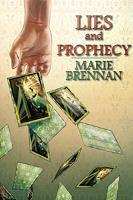 I started with three pieces – two novellas and a novel -- by
I started with three pieces – two novellas and a novel -- byMarie Brennan. I’d never read her work before she joined Book View Café, so
when I found Midnight Never Come in a
bookstore (and it looked interesting), I grabbed it. It’s the first of a series
called “The Onyx Court,” set London during the reign of Elizabeth I. My husband and
I had gone through a phase of watching every film biography of Elizabeth I that
we could find, so that was an automatic plus. Brennan created a second, faerie
court, hidden belowground but interacting in secret ways for England’s benefit.
Fits right in with Sir Francis Walsingham and Dr. John Dee, and other
historical characters. I enjoyed the book immensely, so the first thing I read
was more Brennan, a novella set in the same world although slightly later in time.
Deeds of Men is a murder mystery,
with characteristic Brennan twists. I was glad I’d already read Midnight Never Come because I was
already in love with the main character, but this would also make a good
introduction to the series. I also picked the two “Welton” pieces, a prequel
novella called Welcome To Welton and
then the novel Lies and Prophecy.
Both reminded me a little of Pamela Dean’s excellent Tam Lin, only set at Hogwarts if Hogwarts was a college and magic
was public and widely spread. What kind of curriculum would a college offer?
Dorms, room mates, cafeteria food, professors, meddling parents, the whole
shebang. But Brennan doesn’t leave the story there; it turns out that the
reason people have magical abilities is that they’re descended from fae who
mingled with humans during a time when Faerie was closer to Earth. And now the
two worlds are drawing closer again, and the Seelie and UnSeelie Courts are in deadly
competition for who gets to rule, whether to enslave or ally with humans. And
our college kids are caught up in it all. Brennan’s easy prose and likeable characters
drew me into her world, a lovely escape at the end of each day.
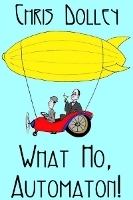
Why, oh why, did I wait so long to read Chris Dolley’s What Ho, Automaton! ? Obviously because I
needed to have not only read P. G. Wodehouse, but have seen the hilarious Jeeves and Wooster with Hugh Laurie and
Stephen Fry. Transport the impeccable “gentleman’s gentleman” into a “gentleman’s
gentleautomaton” and give poor Bertie Wooster a few more brain cells – but not
too many – and you have a delightful, pitch-perfect series of adventures.
Steampunk with class and mannered style!
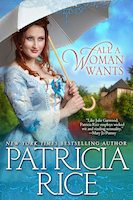 After that, I flipped to the beginning of the alphabet with
After that, I flipped to the beginning of the alphabet withPatricia Rice’s All A Woman Wants.There’s a certain delight in having no expectations of what I’m about to dive
into. This is a Regency Romance, and while I have read Jane Austen’s novels
about a gazillion times (not to mention another marathon of watching the movie
versions), I’m not a Romance reader. The covers turn into pretty much impenetrable
barriers. I decided to give this one a go. To my not-so-great surprise, I
enjoyed both the setting and the dance of attraction and complication between
the two main characters. There were times when I wanted to grab each of them by
the lapels and scream, “Will you get off it and admit you’re in love with each
other?” The question isn’t whether they will do that – we know they will at the
end of the book, but how they get there.
So we’ve got an American sea captain who’s just kidnapped his late sister’s two
kids from their abusive but aristocratic dad, and a newly-orphaned spinster who’s
trying to run a sizeable estate with no education or training but a good deal
of determination and compassion. While waiting for his ship to be ready to hie
him back to Virginia, he hides the kids from the aforementioned deadbeat drunkard-but-powerfully-connected
dad at her estate in exchange for teaching her how to run the place herself. I
loved her insistence on wanting to learn, to understand and be truly independent,
and I often laughed aloud at how he could be so competent in one area and yet
fall apart at the prospect of dealing with two utterly charming hellion kids,
not to mention a woman who insists on “worrying her pretty head” about her responsibilities.
At the end, I came to a new appreciation of how soothing it can be to immerse
myself in a time and situation where love does prevail, but not at the cost of
integrity for both parties.
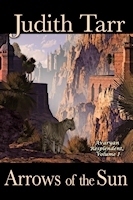
Also in the A’s I spied a couple of Judith Tarr novels and
selected one at random, Arrows of the Sun.
I was pleased to see it was Book I of something but not until I finished did I
discover it was Book I of a second trilogy. This is important because I still
had a wonderful, satisfying reading experience. So many long series assume you
are going to start at the very beginning and not skip a volume. I know readers
who won’t even start a new series until they have all the books in hand. I
guess they’ve been burned by authors who, for one reason or another, fail to
finish a series or fail to do so in a timely manner. This book, while
undoubtedly related to the others I have yet to enjoy, stands beautifully on
its own. It’s got so many of the elements I love in a fantasy: a strong woman
character (more than one, each in her own way!), a conflicted, sensual, earnest
male character, cool horse-like creatures (with horns!) and even cooler
cat-like things, magic and mages and interdimentional Gates, oh my! And plot
twists, lots of flavors of sexuality and love, jealousy and generosity, and characters
that turn out to be not at all what I expected. I won’t offer any more
specifics for fear of spoiling the show. The only thing left to decide is
whether to go back to the first book of the first
trilogy or to continue with this one.
Next up was Vonda N. McIntyre’s delightful and essential Pitfalls of Writing Science Fiction and Fantasy , a
collection of short and pithy essays from a master in the field. In fact, with
a few variations, I’d feel safe in saying it should be required reading for all
writers.
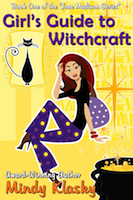
Ready for another leap into the unknown, I picked a new author
and a book I knew nothing about: Girl’sGuide to Witchcraft by Mindy Klasky. Having worked in a college library and
revamped one for a local elementary school, I’m a total sucker for librarians
as hero/ines. Librarians are my heroes, any day of the week. A fun, breezy
style, immediately likeable characters . . . I’m hooked. Hooray! There are more
in the “Jane Madison” series!
I hope you’ll check out some of these books and many more (and maybe some
of my own, also at Book View Café).

Published on October 07, 2013 01:00
October 5, 2013
Friendship as living water
At last we've had some sun, after days of storm and gloomy overcast. Hospice sent a lovely volunteer to sit with my friend, so I took a break and spent the afternoon talking shop and getting my creative batteries "recharged" with a nearby fellow writer. I'm reminded how friends create a network as resilient as any spun by a spider. Friendships work because we're not all crazy -- or needy, or sick -- on the same day. Our love for one another is like water flowing through many channels, all one thing but divided, some sleepy winding rivers or placid waves on the beach, others torrential downpours or waterfalls, or glaciers. Or tsunamis.


Published on October 05, 2013 21:24
October 4, 2013
GUEST BLOG: Katharine Kerr on Writing Long Series
Saga, Series, and Just Plain Long Books
There is nothing an author today has to guard himself
more carefully against than the Saga Habit.
The least slackening of vigilance and the thing has gripped him.
-- P.G.
Wodehouse, writing in 1935
How little
things change! I too am a victim of the
Saga Habit. Fifteen Deverry books, four
Nola O’Gradys -- and I haven’t even finished the Nola series! Now SORCERER’S LUCK, which I a “Runemaster trilogy”. Over the years, a number of people have asked
me why I tend to write at this great length.
I’ve put some thought into the answer, and it can be boiled down one
word: consequences. Well, maybe two
words: consequences and characters. Or
perhaps, consequences, characters, and the subconscious mind, above all the
subconscious mind. You see what I
mean? These things multiply by
themselves.
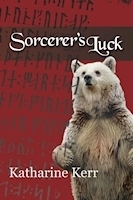
meant to be a
stand-alone, is insisting that it’s only the first volume of
Not all
series books are sagas. Some are shaped
more like beads on a string, separate episodes held together by a set of
characters, who may or may not grow and change as the series continues. Many mystery novels fall into the episode
category, Sherlock Holmes, for example, or James Bond. Other series start out as episodics, but saga
creeps up on them as minor characters bring depth to a plot and demand stories
of their own, for instance, in Lois McMaster Bujold’s Miles Vorkosigan series
or Ian Rankin’s detective novels. What
determines the difference in these examples comes back to the idea of
consequences.
James Bond
can kill people, blow up large portions of real estate, see yet another
girlfriend die horribly -- and have nothing in particular happen as a
consequence, at least, not that the reader or viewer ever learns. I’ve always imagined that a large,
well-financed insurance team comes along after him, squaring everything with
the locals, but we never see that.
Consider, too, Hercule Poirot or other classic detectives in the crime
novel category. They do not grow and
change because they’re a collection of tics and habits. I don’t mean to imply that there’s something
wrong with this, or that episodic works are somehow inferior to sagas. I’m merely pointing out the difference.
An actual
saga demands change, both in its characters and its world. Often the innocent writer starts out by
thinking she’s going to write some simple, stand-alone story, set maybe in a
familiar world, only to find the big guns -- consquence, character, and the
subconscious -- aimed directly at her.
Sagas hijack the writer. At least
they do me.
A good
example is the Deverry series. Back in
1982, I decided to write a fantasy short story about a woman warrior in an
imaginary country. It turned into a
novella before I finished a first draft.
It was also awful -- badly written, undeveloped, pompous. The main character came across as a cardboard
gaming figure. She wanted revenge for
the death of her family. Somehow she’d
managed to learn how to fight with a broadsword. That was all I knew. Who had trained her? Why?
What pushed her to seek a bloody vengeance? What was going to happen to her after she got
it?
The ultimate
answer: like most cardboard, she tore apart.
Pieces of her life appear in the Deverry sequence, but she herself is
gone, too shallow to live. But her
passing spawned a great many other characters, both female and male.
Her actions had only the most minimal
consequence. She killed the murderer --
consequences for him, sure -- but he was a nobleman. What would his death mean to his family? His land holdings? The political hierarchy of which he was a
part? Come to think of it, what was the
political hierarchy in his corner of the fantasy world? Everyone had Celtic names. Their political world would not be a standard
English-French feudal society. People
still worshipped the pagan gods, too.
Why weren’t they Christianized?
The ultimate answer: they weren’t
in Europe. They’d gone elsewhere. A very large elsewhere, as it turned
out. And then of course, I had to ask:
how did they get there?
Now, some people, more sensible
than I am, would have sat down with a couple of notebooks and rationally figured
out the answers to all these questions.
They would have taken their decisions, possibly based on research, back
to the original novella and revised and rewrote until they had a nice short
novel. Those of us addicted to sagas,
however, are not sensible people.
Instead of notes and charts, I wrote more fiction.
Here’s
where the subconsious mind comes in.
Each question a writer asks herself can be answered in two different
ways, with a dry, rational note, or a chunk of story. When she goes for the story option, the saga
takes over. To continue my novella
example, I wrote the scene where the dead lord’s body comes back to his castle,
which promptly told me it was a dun, not a castle, thereby filling in a bit more
of the background. In the scene of mourning
other noble lords were already plotting to get hold of his land, maybe by
appealling to an overlord, maybe by marrying off his widow to a younger
son. The story possibilities in that
were too good to ignore.
You can see their ultimate
expression in Books Three and Four of the Deverry saga with It just
took me a while to get there. The woman
warrior, complete with motivation and several past lives’ worth of history, appears in the saga as Jill, Cullyn
of Cerrmor’s daughter, but she is not the same person as that first piece of
cardboard, not at all. The opening of
the original novella, when a woman dressed as a boy sees a pair of silver
daggers eating in an innyard, does appear in a different context with different
characters in Book Six, when Carra meets Rhodry and Yraen. Rather than revenge, however, she’s seeking
the father of her unborn child.
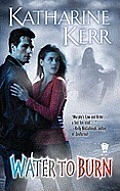
the hassle over the
re-assignment of Dun Bruddlyn.
More story
brings more questions. The writer’s
mind works on story, not “information”.
Pieces of information can act as the gateways that open into stories and
lead the writer into a saga. Tolkien
started his vast saga by noticing some odd discrepancies in the vocabulary of
Old Norse. Sounds dull, doesn’t it? But he made something exciting out of
it. The difference between varg
and ulf was just a gate, an innocent little opening leading to a vast
life’s work.
Not every
writer works in the same way, of course.
Many writers make an outline, draw up character sheets, plan the
structure of the book to be, and then stick to their original decisions. Often they turn out good books that way,
too. I don’t understand how, but they
do. I personally am a “discovery
writer”, as we’re termed, someone who plans the book by writing it and then
revising the entire thing. When it comes
to saga, this means writing large chunks of prose before any of it coalesces
into a book. I never finished any of the
first drafts of these chunks. Later I
did, when I was fitting them into the overall series.
(Someone like
Tolkien, who had a family and a day job, may never get to finish all of his
early explorations of the material. Such
is one risk of saga. Readers who
criticize him and his heirs for all those “unfinished tales” need to understand
where the tales came from. Anything
beyond a mere jotting belongs to the saga.)
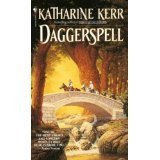
Another
risk: the writer can put a lot of energy into a character or tale only to see
that it doesn’t belong and must be scrapped.
When I was trying to turn the original ghastly novella into DAGGERSPELL,
the first Deverry novel, the most important dweomerman was an apothecary named
Liddyn, a nice fellow, not real interesting though. My subconscious created a friend of his, a
very minor character, who appeared in one small scene, digging herbs by the
side of the road. When the friend
insisted on turning up in a later scene, I named him Nevyn. If I’d stuck to my original plan, that would
have been it for Nevyn. As soon as I
asked myself, “but who is this guy?” I realized what he was bringing with him:
the entire theme of past lives. Until
that moment, reincarnation had nothing to do with this saga.
Liddyn
shrank to one mention in one of the later books. Nevyn took over.
The past lives appeared when I
asked myself how this new strange character got to be a four hundred year old
master of magic. What was his
motivation? How and why did he study
dweomer? These questions brings us right
back to the idea of consequences. As a
young man Nevyn made a bad mistake out of simple arrogance. The consequences were dire for the woman who
loved him and her clan, and over the years these consequences spiralled out of
control until they led ultimately to a civil war. The saga had gotten longer but deeper, and I
hope richer. Had I ignored these
consequences, I would have been left with an interesting episode, isolated, a
little thin, perhaps at best backstory.
The term
“backstory” always implies a “frontstory”, of course, the main action, the most
important part of a book. Some readers
get impatient if they feel there’s too much of this mysterious substance,
backstory, in a given book or movie.
They want to know what they’re getting, where the story is going, and in
particular, what kind of story it is, front and center. Sagas, however, can’t be divided into back
and front. Is the Trojan War less
important than Odysseus’s wanderings?
The one is not “backstory” to the other.
The saga
has much in common with the literary form critics call the “roman fleuve,” the
river-system novel. A great many stories
flow together in one of these, like the tributaries that together make up a
mighty river meandering across a plain.
The classic example is Balzac’s Comedie Humaine. Romans fleuve follow a wide cast of
characters over a stretch of time, just as true sagas do. None of the stories are less important than
any other.
The past and present of the created
world together produce the last essential element of a saga: the feeling of
change, of movement forward in time of the saga’s world. In a true saga something always passes away,
but at the same time, something new arrives.
The elves leave Middle Earth, but the Fourth Age begins. True sagas, in short, include a future.
And that
future often calls the writer back to the saga.
Sometimes the damn things won’t leave us alone. Which is why I find myself contemplating a
return to Deverry for a novel that takes place hundreds of years after the main
saga. It should be a stand-alone, I
think. But I’m not betting on that.

Published on October 04, 2013 01:00
October 3, 2013
SHANNIVAR cover!
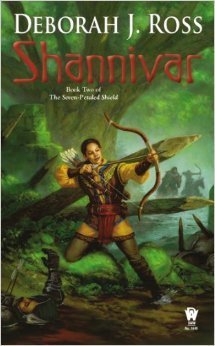
Here's the cover for Shannivar, the second book of The Seven-Petaled Shield. I am so pleased with the artwork by Matt Stawicki! It's available for pre-order at the usual places, for an early December release.

Published on October 03, 2013 16:26
October 2, 2013
Evil, the Fantastic, and Making Sense Out of Pain
After a brief hiatus, I've returned to the Great Traveling Fantasy Round Table. This month's topic, hosted by Warren Rochelle, is "Evil and the Fantastic." My entry is below, but please go read the others. And write your own!
***
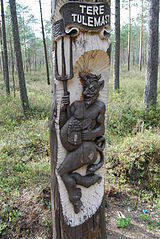
I don’t think it’s possible to discuss evil without talking
about the literature of the fantastic. We hear people talk about “evil
incarnate,” usually in reference to some person or institution that has committed
particularly heinous acts, as if evil were a tangible, measurable thing that
exists outside the human imagination. In real life, things are rarely that
simplistic.
Certainly, history and even some current religious thought puts
forth the notion of those, human or not, who are inherently evil. To this day,
some people believe that snakes (or spiders or other animals) are evil (I
encountered one such man in a pet store, warning his young son that the garter
snake would steal his soul if he weren’t careful). Once the mentally ill (or
physically ill, such as those who suffer from epilepsy) were thought to be
possessed by demons. Such beliefs persist today on the fringes of mainstream
Western society, although they have largely been expunged from medical and
psychiatric practice. We believe that such conditions as schizophrenia and
sociopathy arise from disorders of neurophysiology, even if we cannot yet
pinpoint the precise etiology. Even when we do know exactly what
neurotransmitters and part of the brain are involved, it is still a widespread
and understandable human tendency to ascribe unexplained phenomena, whether
beneficial or destructive, to supernatural agency. Even though intellectually
we may understand that a mass murderer is not an incarnation of some demonic
spirit, nor is he possessed by one, and even if we cannot explain why such a
person is utterly lacking in empathy for other human beings, we still often use
words like evil, wicked, damned,
devilish, satanic, and demonic.
Humans are capable of cruelty and viciousness so extreme in
degree or scope that few of us can comprehend it, let alone the motivation
behind it. How can we make sense of atrocities like the Holocaust or its
equivalents, historical or modern? Of the massacres in Africa, Central Europe,
the Middle East, and Southeast Asia, to name but a few?
I think we can’t, not by ordinary thought. The mind numbs
with the magnitude of such

deliberately inflicted suffering and takes refuge in
numbers, pop psychology, and political analysis. It is difficult enough to
struggle with the petty unkindnesses of everyday life, the irritations, the
mundane acts of thoughtlessness, the emotions like jealousy or vindictiveness.
Almost everyone loses their temper with one another at one time or another, or
an unhealed resentment prompts them to strike out without thinking. These acts
are understandable even when we disapprove of them, because they lie within the
scope of our own experience. As we seek forgiveness for ourselves, we find the means
to extend it to others. While these moments, and the means of making and
accepting amends, smooth our relationships, they don’t make for a very dramatic
tale.
Fantastical literature, on the other hand, enlarges the
sphere of reality. This could be the introduction of magical elements into the
ordinary world (urban fantasy), or parallel worlds (such as Faerie or Narnia)
that interact with our own, each with its own set of rules. Or completely
independent worlds (Discworld, Middle Earth).
Fantastical literature is also characterized by the use of
archetype and metaphor to evoke experiences for which we have no direct
vocabulary. We don’t need to have personally surrendered to the Dark Side of
the Force in order to understand why the temptation is at once seductive and
terrifying. Nor do we need to have witnessed an atomic bomb blast to imagine
the devastation of dragonfire or a wrathful volcano god/dess.
In discussing how to portray interesting, multi-dimensional
villains, it’s often pointed out that these characters – antagonists to the
point of view character – are often heroes in their own eyes. They don’t get up
in the morning, look in the mirror, and say, “I’m going to be evil today” or
“Evil! Evil! Rah-rah-rah!” The best and most frightening villains have the same
capacity for greatness as do heroes, whether it is physical prowess, intellect,
a wounded heart, or simple charisma, only it is applied either in the wrong
manner or for the wrong ends. If a tragic hero has a fatal flaw but is
nonetheless admirable, then a great villain also has his blind spots, to his
ultimate ruin.
Evil in fantastical literature ranges from the motivating
force in such otherwise sympathetic villains to a “pure” black-and-white
quality, one that is so alien to ordinary human sensibilities as to be utterly
incomprehensible. We cannot know what it is, but we can know its effects – what
it does to individuals, nations, and entire worlds. Black-and-white evil is in
most instances a whole lot less interesting than those who come under its influence
but still retain some degree of choice. That choice may be a once-and-for-all
decision, informed or otherwise, or it can be the continuing possibility of
turning away from the inevitable consequences, a possibility that diminishes
with each step toward the abyss.
If Evil is monolithic, unmixed with any goodness, and
incapable of change, then the resolution of the story conflict is reduced to
either/or, yes/no, win/lose. This is not to say that such tales are less adrenaline-fueled
than those that are more complex, only that there are fewer possibilities for a
denouement: Evil wins and everyone dies/suffers; Good wins and the hero lives
happily ever after; Good wins but the hero meets a tragic, sacrificial end. The
first two may lead to an exciting climax and catharsis but are unlikely to
offer the deeper emotional resonance of the third. If, on the other hand, Evil
is one among many conflicting motivations, other resolutions become possible.
The evil character discovers the capacity for love and sacrifices himself for a
greater cause; the hero and villain form an alliance; either hero or villain
crosses the gulf between them and healing ensues; the villain makes a
last-ditch effort to salvage some good from the harm he has done; the
possibilities become endless. All these rely on the capacity of sentient beings
to choose their future actions, even when they had no power over what happened
to them in the past and cannot undo what they have done. And in the course of
these journeys, we ourselves gain insight into our own unhealed wounds, our
festering resentments, our self-condemnation, and ultimately, our hope for
redemption.
***
P.S. If you enjoy my blog writing, I hope you'll check out my fiction.
***
Devil sign, photo by Miraceli, Licensed under Creative Commons.
"To The Accuser" is by William Blake, in public domain.

***

I don’t think it’s possible to discuss evil without talking
about the literature of the fantastic. We hear people talk about “evil
incarnate,” usually in reference to some person or institution that has committed
particularly heinous acts, as if evil were a tangible, measurable thing that
exists outside the human imagination. In real life, things are rarely that
simplistic.
Certainly, history and even some current religious thought puts
forth the notion of those, human or not, who are inherently evil. To this day,
some people believe that snakes (or spiders or other animals) are evil (I
encountered one such man in a pet store, warning his young son that the garter
snake would steal his soul if he weren’t careful). Once the mentally ill (or
physically ill, such as those who suffer from epilepsy) were thought to be
possessed by demons. Such beliefs persist today on the fringes of mainstream
Western society, although they have largely been expunged from medical and
psychiatric practice. We believe that such conditions as schizophrenia and
sociopathy arise from disorders of neurophysiology, even if we cannot yet
pinpoint the precise etiology. Even when we do know exactly what
neurotransmitters and part of the brain are involved, it is still a widespread
and understandable human tendency to ascribe unexplained phenomena, whether
beneficial or destructive, to supernatural agency. Even though intellectually
we may understand that a mass murderer is not an incarnation of some demonic
spirit, nor is he possessed by one, and even if we cannot explain why such a
person is utterly lacking in empathy for other human beings, we still often use
words like evil, wicked, damned,
devilish, satanic, and demonic.
Humans are capable of cruelty and viciousness so extreme in
degree or scope that few of us can comprehend it, let alone the motivation
behind it. How can we make sense of atrocities like the Holocaust or its
equivalents, historical or modern? Of the massacres in Africa, Central Europe,
the Middle East, and Southeast Asia, to name but a few?
I think we can’t, not by ordinary thought. The mind numbs
with the magnitude of such

deliberately inflicted suffering and takes refuge in
numbers, pop psychology, and political analysis. It is difficult enough to
struggle with the petty unkindnesses of everyday life, the irritations, the
mundane acts of thoughtlessness, the emotions like jealousy or vindictiveness.
Almost everyone loses their temper with one another at one time or another, or
an unhealed resentment prompts them to strike out without thinking. These acts
are understandable even when we disapprove of them, because they lie within the
scope of our own experience. As we seek forgiveness for ourselves, we find the means
to extend it to others. While these moments, and the means of making and
accepting amends, smooth our relationships, they don’t make for a very dramatic
tale.
Fantastical literature, on the other hand, enlarges the
sphere of reality. This could be the introduction of magical elements into the
ordinary world (urban fantasy), or parallel worlds (such as Faerie or Narnia)
that interact with our own, each with its own set of rules. Or completely
independent worlds (Discworld, Middle Earth).
Fantastical literature is also characterized by the use of
archetype and metaphor to evoke experiences for which we have no direct
vocabulary. We don’t need to have personally surrendered to the Dark Side of
the Force in order to understand why the temptation is at once seductive and
terrifying. Nor do we need to have witnessed an atomic bomb blast to imagine
the devastation of dragonfire or a wrathful volcano god/dess.
In discussing how to portray interesting, multi-dimensional
villains, it’s often pointed out that these characters – antagonists to the
point of view character – are often heroes in their own eyes. They don’t get up
in the morning, look in the mirror, and say, “I’m going to be evil today” or
“Evil! Evil! Rah-rah-rah!” The best and most frightening villains have the same
capacity for greatness as do heroes, whether it is physical prowess, intellect,
a wounded heart, or simple charisma, only it is applied either in the wrong
manner or for the wrong ends. If a tragic hero has a fatal flaw but is
nonetheless admirable, then a great villain also has his blind spots, to his
ultimate ruin.
Evil in fantastical literature ranges from the motivating
force in such otherwise sympathetic villains to a “pure” black-and-white
quality, one that is so alien to ordinary human sensibilities as to be utterly
incomprehensible. We cannot know what it is, but we can know its effects – what
it does to individuals, nations, and entire worlds. Black-and-white evil is in
most instances a whole lot less interesting than those who come under its influence
but still retain some degree of choice. That choice may be a once-and-for-all
decision, informed or otherwise, or it can be the continuing possibility of
turning away from the inevitable consequences, a possibility that diminishes
with each step toward the abyss.
If Evil is monolithic, unmixed with any goodness, and
incapable of change, then the resolution of the story conflict is reduced to
either/or, yes/no, win/lose. This is not to say that such tales are less adrenaline-fueled
than those that are more complex, only that there are fewer possibilities for a
denouement: Evil wins and everyone dies/suffers; Good wins and the hero lives
happily ever after; Good wins but the hero meets a tragic, sacrificial end. The
first two may lead to an exciting climax and catharsis but are unlikely to
offer the deeper emotional resonance of the third. If, on the other hand, Evil
is one among many conflicting motivations, other resolutions become possible.
The evil character discovers the capacity for love and sacrifices himself for a
greater cause; the hero and villain form an alliance; either hero or villain
crosses the gulf between them and healing ensues; the villain makes a
last-ditch effort to salvage some good from the harm he has done; the
possibilities become endless. All these rely on the capacity of sentient beings
to choose their future actions, even when they had no power over what happened
to them in the past and cannot undo what they have done. And in the course of
these journeys, we ourselves gain insight into our own unhealed wounds, our
festering resentments, our self-condemnation, and ultimately, our hope for
redemption.
***
P.S. If you enjoy my blog writing, I hope you'll check out my fiction.
***
Devil sign, photo by Miraceli, Licensed under Creative Commons.
"To The Accuser" is by William Blake, in public domain.

Published on October 02, 2013 01:00

